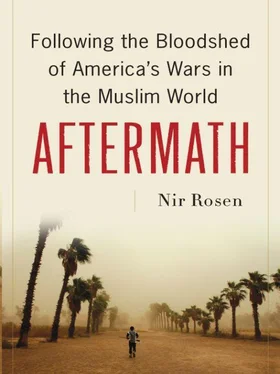Abu Anas was originally from the Bedawi camp in northern Lebanon and had grown up in a conservative family. He had fled from the north to Ayn al-Hilweh in 2000 because of his involvement in clashes with the Lebanese army. On December 31, 1999, Islamist radicals battled the Lebanese army in northeastern Lebanon’s Sir al-Dinniyeh, led by a Lebanese veteran of the Afghan and Bosnian wars called Basim al-Kanj. Kanj had returned to Lebanon and established his own network, recruiting in the slums of Tripoli and Ayn al-Hilweh and establishing ties with Usbat al-Ansar. With Usbat’s help he established training camps in Dinniyeh. Kanj ordered his men to take over a radio station near the camps that had belonged to Lebanon’s leading Salafi cleric, Sheikh Dai al-Islam al-Shahal. (His father had first brought Salafism to Lebanon in 1940, but it was Dai al-Islam and his brother who really brought Salafism to northern Lebanon.)
Only months before, churches in Tripoli had been attacked, and some of the suspects had fled to Dinniyeh. Shahal and other Sunni clerics as well as local officials tried to mediate between the army and the militants. When an army patrol passed by, negotiations were suspended. Fighting broke out, and fifteen of the Islamists died along with eleven soldiers and five civilians, although Kanj had not sought such a confrontation. The Dinniyeh group was small, but dozens of Salafis were arrested in Tripoli and radicalized in prison.
The Dinniyeh incident, along with an attack on the Russian embassy and similar incidents, were the first signs that Salafi jihadism was establishing a presence in Lebanon. One lesson of the incident was that the poverty and neglect in northern Lebanon could affect the rest of the country, but this was forgotten until February 5, 2006, when rioters came down from the north in buses provided by the Sunni Endowment and rampaged through Christian neighborhoods in Beirut, seeking vengeance for the Danish cartoons of the Prophet Muhammad. Christians were shocked, as security forces were nowhere to be found despite having advance notice of the demonstration. Those rioters who were arrested were quickly released. Ahmad Fatfat, who was interior minister in 2005, had struggled to release the Dinniyeh prisoners in order to gain the support of northern Sunnis and Salafis. As a concession to Christians the government then released Samir Geagea, the notorious war criminal who had killed Palestinians as well as Christian rivals during the 1980s. Much fanfare met the release of the Dinniyeh prisoners; the episode was televised and used to demonstrate that the government was pro-Sunni. Some of them had belonged to Harakat al-Tawhid al-Islami (The Islamic Unity Movement), the main Islamist militia that fought the Syrian presence in northern Lebanon in the 1980s. In the shifting alliances of Lebanese militias, Tawhid is now considered pro-Syrian.
Abu Anas blamed the Lebanese army for the clashes. “They wanted Hizballah to control the conflict with Israel,” he said. “The Lebanese army ambushed them, and during the negotiations they surrounded them and attacked them.” Abu Anas had previously belonged to Tawhid. More than fifty Palestinians had belonged to Tawhid, he told me. Many had gone on to other Islamist movements.
In May 2007 members of a new and somewhat mysterious jihadist group, Fatah al-Islam, robbed a bank in Tripoli, provoking clashes with the army. Salafi militants also robbed banks in Sidon and other parts of the country. “Al Qaeda uses credit cards to fund themselves, and they rob banks and companies that are infidel to fund themselves,” Abu Ghassan explained. “They don’t rob in a criminal way. They don’t want to hurt anybody. There is a difference between killing people and taking money that belongs to Muslim people.” Although most of the soldiers battling Fatah al-Islam in the north were Sunnis, Abu Ghassan did not blame Sunnis. “The Lebanese army answers to the government, and even though the head of government is a Sunni, the orders come from America. They are not fighting as Sunnis but as soldiers, getting orders, and they think Fatah al-Islam are terrorists.” I asked him what he thought. “I think Fatah al-Islam are good people,” he said.
The Mystery of Fatah al-Islam
The origins of Fatah al-Islam are nebulous, but based on meetings with Palestinian faction leaders and security officials, as well as documents obtained from their interrogation of the group’s members, I pieced together its history. In the summer of 2006 new faces appeared in Shatila and Burj al-Barajneh, the Palestinian camps of Beirut, and in Bedawi and Nahr al-Barid, the camps near the northern city of Tripoli. The men were clearly religious, and they were assumed to be Salafis. They had long beards, and some even wore the Afghan salwar kameez . Some were clearly foreign. When camp security inquired about the newcomers, they were told, curiously, that the men belonged to Fatah al-Intifada’s “Western Section,” a traditionally leftist, broadly secular Syrian-allied Palestinian group that split from the Palestine Liberation Organization in 1983, which was preparing fighters to go to Palestine. Others claimed they were “from the inside,” meaning from Palestine itself. During Israel’s July 2006 war on Lebanon, more Salafi fighters arrived in these camps, in part because a Fatah al-Intifada camp near the Syrian border in eastern Lebanon was evacuated during the war. Suspicions were aroused because the left-leaning Fatah al-Intifada was known to pay low salaries but some of the newcomers had laptops and went around on motorcycles. The newcomers were led by Shaker al-Absi, a veteran Fatah al-Intifada officer who had been trained as a pilot in Libya and served as one in North Yemen, in addition to fighting in Nicaragua. Absi was in his fifties. A Palestinian born in Jordan, he had spent most of his life in Syrian and Lebanese camps. He was likely disillusioned with the aging and moribund Arab left—which groups like Fatah al-Intifada epitomized—and he was said to have been very religious. In 2002 he was arrested with fifteen others for trying to infiltrate the Israeli-occupied Golan Heights. He spent two and a half years in jail, and was said to have gone to Iraq after his release, eventually making his way to the Helweh camp in the Beqaa Valley, by the Syrian border. There he and his followers trained volunteers, including young men from the slums of Tripoli, to fight in Iraq. Gulf Arabs who flew to Beirut to go to Iraq also gathered there. They were segregated from the rest of the camp and better financed, eating better food like lamb.
When Zarqawi died, some of his men came to Lebanon. Some Salafis were diverted to the Burj al-Barajneh camp to serve as a bulwark against the Shiite suburbs of Beirut, known as Dahiyeh. Many Syrians and Palestinian Syrians who had fought in Iraq and become radicalized there made their way to Lebanon. More than two hundred such men had left Damascus’s Yarmuk refugee camp to fight in Iraq with Zarqawi, even though that camp was dominated by the far more moderate Hamas movement. Abu Midyan was one of the foreign fighters who left Iraq because of concerns about the state of the jihad there. He led other comrades in arms from Iraq to Yarmuk, but the Syrians pressured them to leave, so they moved to Lebanon’s camps, where they began to recruit from the poor.
Abu Yasser, the Fatah al-Intifada leader for northern Lebanon, was surprised because the newcomers were bearded, prayed five times a day, and abstained from smoking. He asked his superior, the Syrian-based Abu Khalid al-Amli, deputy commander of Fatah al-Intifada, who the newcomers were. “We have new fighters,” he said. “We must learn from Hizballah’s military and discipline. They are destined for Gaza.” Abu Khalid was also sending jihadists to Ayn al-Hilweh. Abu Yasser was surprised and unsettled by the presence of foreigners among them. “Their commanders were Palestinians, and they were independent of us,” he said. When other factions asked Fatah al-Intifada who the new men were, they were told cryptically that it was an “internal matter.” Shaker al-Absi was the third-ranking official in Fatah al-Intifada, and his authority exceeded that of Abu Yasser’s. “I accepted Shaker but didn’t control him,” said Abu Yasser. Abu Musa, the commander of Fatah al-Intifada in Syria, began to complain that he did not know what was happening in his own organization.
Читать дальше











